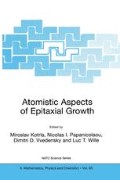Abstract
We present results on the problem of surface instability induced by a uniaxial stress. We show that the surface modulation leads to a cellular structure with deep grooves, and a coarsening occurs in that wide cells grow at the expense of thin ones. We present both numerical and analytical results, and discuss the implication of this instability in the formation of quantum dots. We suggest a mechanism that may explain the experimental fact according to which quantum dots occur rather for compressive than for a tensile strain without evoking anharmonicity.
Access this chapter
Tax calculation will be finalised at checkout
Purchases are for personal use only
Preview
Unable to display preview. Download preview PDF.
References
Asaro, A., and Tiller, W. (1972) Interface morphology development during stress corrosion cracking. I. Via surface diffusion, Metall. Thins. 3, pp. 1789–1796.
Grinfeld, M.A. (1986) Instability of the interface between a non-hydrostatically stressed elastic body and melts, Dokl, Acad. Nauk. SSSR 290, pp. 1358-1363 [Sov. Phys. Dokl. 31, pp 831-834.]
Nozières, P. (1993) Amplitude expansion for the Grinfeld instability due to uniaxial stress at a solid surface, J. Phys. Prance I 3, pp. 681–686.
Yang, W. J., and Srolovitz, D. J. (1993) Crack-like surface instabilities in stressed solids, Phys. Rev. Lett. 71, pp. 1593–1596.
Kassner, K., and Misbah, C. (1994) Nonlinear evolution of a uniaxially stressed solid—A route to fracture, Europhys. Lett. 28, pp. 245–250.
Kassner, K., and Misbah, C. (1999) A phase-field approach for stress-induced instabilities, Europhys. Lett. 46, pp. 217–223.
Müller, J., and Grant, M. (1999) Model of surface instabilities induced by stress, Phys. Rev. Lett. 82, pp. 1736–1739.
Jaccodine, R. J. (1963) Surface energy of germanium and silicon, J. Electrochem. Sac. 110, pp. 524–527.
Nötzel R., Temmyo, J., and Tamamura, T. (1994) Self-organized growth of strained InGaAs quantum disks, Nature 389, pp. 131–133.
Cantat, I., Kassner, K., Misbah, C, and Müller-Krumbhaar, H. (1998) Directional solidification under stress, Phys. Rev. E 58, pp. 6027–6040.
Torii, R. H., and Balibar, S. (1992) Helium crystals under stress—The Grinfeld Instability, J. Low Temp. Phys. 80, pp. 391–400.
Mullins, W. W. (1957) Theory of thermal grooving,J. Appl. Phys. 28, pp. 333–339.
Villain, J. (1991) Continuum models of crystal-growth from atomic-beams with and without desorption, J. Phys. Prance I 1, pp. 19–42.
Herring, C. (1950) Diffusional viscosity of a polycrystalline solid, J. Appl. Phys. 21, pp. 437–445.
Kassner, K., Misbah, C, Müler, J., Kohlert, P., and Kappey J. (2001) Phase-field modeling of stress-induced instabilities, Phys. Rev. E 63, art. no. 036117.
Durand, I., Kassner, K., Misbah, C, and Müller-Krumbhaar, H. (1996) Strong coupling between diffusive and elastic instabilities in directional solidification, Phys. Rev. Lett. 76, pp. 3013–3016.
Csahok, Z., Misbah, C, and Valance, A. (1999) A class of nonlinear front evolution equations derived from geometry and conservation, Physica D 128, pp. 87–100.
Priester, C. and Lannoo, M. (1995) Origin of self-organized quantum dots in highly mismatched heteroepitaxy, Phys. Rev. Lett. 75, pp. 93–96.
Author information
Authors and Affiliations
Editor information
Editors and Affiliations
Rights and permissions
Copyright information
© 2002 Springer Science+Business Media Dordrecht
About this chapter
Cite this chapter
Misbah, C., Berger, P., Kassner, K. (2002). Stress-Induced Surface Modulation. In: Kotrla, M., Papanicolaou, N.I., Vvedensky, D.D., Wille, L.T. (eds) Atomistic Aspects of Epitaxial Growth. NATO Science Series, vol 65. Springer, Dordrecht. https://doi.org/10.1007/978-94-010-0391-9_29
Download citation
DOI: https://doi.org/10.1007/978-94-010-0391-9_29
Publisher Name: Springer, Dordrecht
Print ISBN: 978-1-4020-0675-3
Online ISBN: 978-94-010-0391-9
eBook Packages: Springer Book Archive

